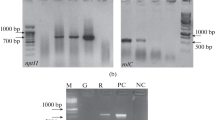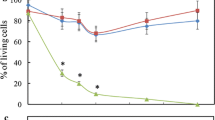Summary
The isoflavone daidzein, the coumestanes coumestrol and soyagol as well as 2′,4,4′-trihydroxychalcone were isolated from callus and cell suspensions of root tip tissue from Phaseolus aureus Roxb. Upon prolonged culturing callus suspensions gradually became cell suspensions, a process which was accompanied by a decrease in the accumulation of phenolics. Upon transfer of the cells into 3 different media containing β-indolyl acetic acid, kinetin or α-naphthalene acetic acid, a drastic increase in the amount of coumestrol was measured.
The data are discussed in relation to the observed differentiation of the cultures after application of the various hormones. The cultures were shown to metabolize daidzein and other phenylpropanoid compounds. A pronounced binding of daidzein to polymeric, ethanol-insoluble material is discussed in relation to our earlier findings in isoflavone metabolism.
Similar content being viewed by others
Literatur
Bailey, J. A.: Pisatin production by tissue cultures of Pisum sativum L. J. gen. Microbiol. 61, 409–415 (1970).
Barz, W.: Stoffwechsel aromatischer Pflanzeninhaltsstoffe. I. Über den Umsatz von Isoflavonen und Cumöstanen in Cicer arietinum L. und Phaseolus aureus Roxb. Z. Naturforsch. 24b, 234–239 (1969).
—: Über den Einfluß von Licht auf den Umsatz der Isoflavone Formononetin und Biochanin A in Cicer arietinum L. Planta (Berl.) 90, 191–202 (1970a).
—: The degradation of Formononetin and Daidzein in Cicer arietinum L. and Phaseolus aureaus Roxb. Phytochem. 9, 1735–1744 (1970b).
—: Über den Einfluß von Licht auf den Umsatz von Flavonolen und Isoflavonen in Cicer arietinum L. Phytochem., 10, 343–349 (1971).
Becker, H.: Stoffproduktion in pflanzlichen Callus- und Organkulturen. Mitt. dtsch. pharmaz. Ges. 39, 273–279 (1969).
Bu'Lock, J. D.: Biosynthese von Naturstoffen. München: Bayerischer Landwirtschafts Verlag 1970.
Carew, D. P., Staba, E. J.: Plant tissue culture: its fundamentals application and relationship to medicinal plant Studies. Lloydia 28, 1–26 (1965).
Constabel, F., Shyluk, J. P., Gamborg, O. L.: The effect of hormones on anthocyanin accumulation in cell cultures of Haplopappus gracilis. Planta (Berl.) 96, 306–316 (1971).
Dewick, P. M., Barz, W., Grisebach, H.: Biosynthesis of coumestrol in Phaseolus aureus Roxb. Phytochem. 9, 775–783 (1970).
Ellis, B. E., Towers, G. H. N.: Degradation of aromatic compounds by sterile plant tissues. Phytochem. 9, 1457–1461 (1970).
Forrest, G. J.: Studies on polyphenol metabolism of tissue cultures derived from the tea plant (Camellia sinensis L.). Biochem. J. 113, 765–772 (1969).
Fritig, B., Hirth, L., Ourisson, G.: Biosynthesis of the coumarins: Scopoletin formation in tobacco tissue cultures. Phytochem. 9, 1963–1975 (1970).
Gamborg, O. L.: Aromatic metabolism in plants. II. Enzymes of the shikimate pathway in suspension cultures of plant cells. Canad. J. Biochem. 44, 791–799 (1966).
Hahlbrock, K., Wellmann, E.: Light-induced flavone biosynthesis and activity of phenylalanine ammonia-lyase and UDP-apiose synthetase in cell suspension cultures of Petroselinum hortense. Planta (Berl.) 94, 236–239 (1970).
Harms, H., Söchtig, H., Haider, K.: Untersuchungen zur Aufnahme und Umwandlung C14-markierter Phenole durch die Pflanze. I. Aufnahme von C14-carboxylmarkierter p-Hydroxybenzoe-, Vanillin- und Syringasäure durch die Wurzeln von Weizenkeimpflanzen und Verteilung der Aktivität über die Pflanze. Plant and Soil, 31, 129–142 (1969a).
—: II. Die Umwandlung von p-Hydroxybenzoesäure, Vanillinsäure sowie Syringasäure nach der Aufnahme durch die Wurzeln von Weizenkeimpflanzen. Plant and Soil 31, 257–272 (1969b).
Hösel, W., Barz, W.: Flavonoide aus Cicer arietinum L. Phytochem. 9, 2053–2056 (1970).
Janistyn, B., Barz, W., Pohl, R.: Abbau des 2′,4,4′,6′-Tetrahydroxychalkon-2′-β-D-glukosids durch Callussuspensionskulturen von Pisum sativum L. Z. Naturforsch., im Druck (1971).
Jeffay, H., Alvarez, J.: Liquid scintillation counting of carbon-14C. Use of ethanoleamine — ethylene glycol monomethylether — toluene. Analyt. Chem. 33, 612–615 (1961).
Mabry, T. J., Markham, K. R., Thomas, M. B.: The systematic identification of flavonoids. Berlin-Heidelberg-New York: Springer 1970.
Miller, C. O.: Control of deoxyisoflavone synthesis in soybean tissue. Planta (Berl.) 87, 26–35 (1969).
Pillai, S. K., Hildebrandt, A. C.: Induced differentiation of geranium plants from undifferentiated callus in vitro. Amer. J. Bot. 56, 52–58 (1969). (Vgl. auch dort zitierte Literatur.)
Robertson, N. F., Frien, J., Aveyard, M., Brown, J., Huffe, M., Homans, A. L.: The accumulation of phenolic acids in tissue culture pathogen combinations of Solanum tuberosum and Phytophthora infestans. J. gen. Microbiol. 54, 261–268 (1968).
Sayagaver, B. M., Mulchandani, N. B., Narayanaswamy, S.: Isolation of formononetin from tissue cultures of Cicer arietinum. Lloydia 32, 108–109 (1969).
Scott, A. I.: Oxidative coupling of phenolic compounds. Quart. Rev. 19, 1–35 (1965).
Sears, K. D., Casebier, R. L.: The reaction of thioglycolic acid with polyflavonoid bark fractions of Tsuga heterophylla. Phytochem. 9, 1589–1594 (1970).
Staba, E. J.: Plant tissue culture as a technique for the phytochemist. Recent Adv. Phytochem. 2, 75–106 (1969).
Vasil, J. K., Hildebrandt, A. C.: Variations of morphogenetic behavior in plant tissue cultures. I. Cichorium endivia Linn. Amer. J. Bot. 53, 860–869 (1966a).
—: Variations of morphogenetic behavior in plant tissue cultures. II. Petroselinum hortense. Amer. J. Bot. 53, 869–874 (1966b).
—: Further studies on the growth and differentiation of single, isolated cells of tobacco in vitro. Planta (Berl.) 75, 139–151 (1967).
Weinges, K., Bähr, W., Ebert, W., Göritz, K., Marx, H.-D.: Konstitution, Entstehung und Bedeutung der Flavonoid-Gerbstoffe. Fort. Chem. org. Naturstoffe 27, 158–260 (1969).
Zilg, H., Grisebach, H.: Biosynthesis of isoflavones. XVII. Identification and biosynthesis of coumestanes in Soya hispida. Phytochem. 7, 1765–1772 (1968a).
—: Über die Bedeutung der Isoflavanone bei der Isoflavonbiosynthese. Z. Naturforsch. 23b, 494–504 (1968b).
Author information
Authors and Affiliations
Rights and permissions
About this article
Cite this article
Berlin, J., Barz, W. Stoffwechsel von Isoflavonen und Cumöstanen in Zell- und Callussuspensionskulturen von Phaseolus aureus Roxb.. Planta 98, 300–314 (1971). https://doi.org/10.1007/BF00380231
Received:
Issue Date:
DOI: https://doi.org/10.1007/BF00380231




